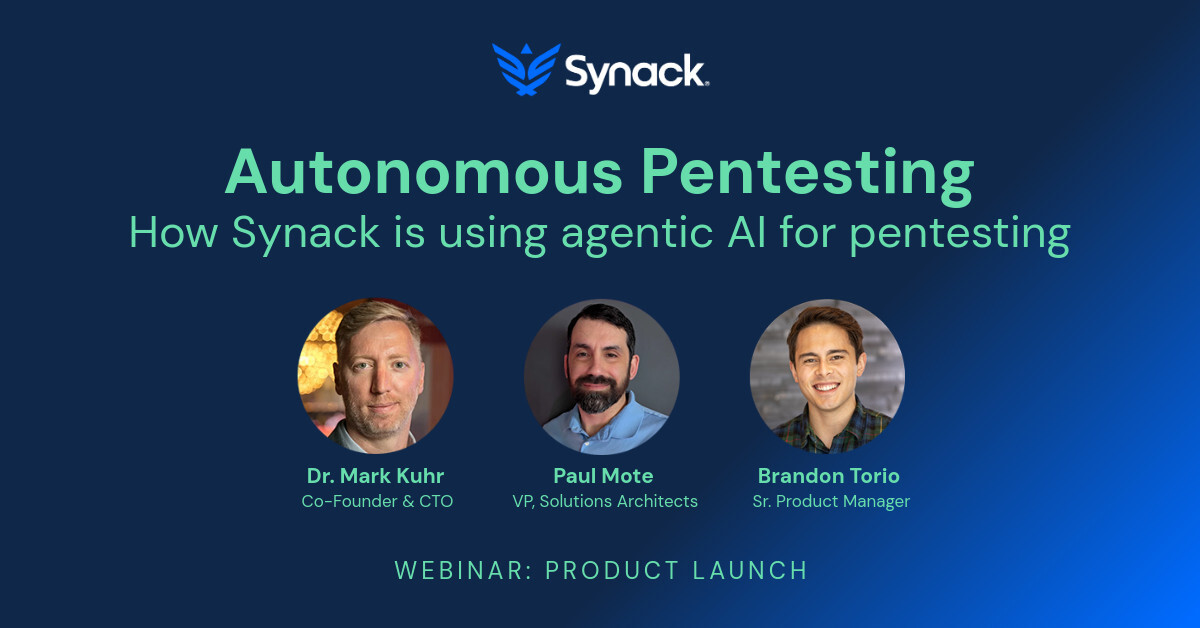Agentic AI pentesting uses autonomous AI agents to plan, run, learn from, and reconfigure multi-step penetration tests. AI agents can simulate an attacker’s behavior and adapt strategies based on new information to provide continuous, rapid, and scalable security validation. These functions are complemented by humans who make judgments, handle any high-risk actions, and bring complex creative thinking to the testing program.
Human vs. Agentic AI Pentesting
| Human Pentesting | Agentic AI Pentesting | |
| What | A small, internal team or a single consulting firm | A team of autonomous AI agents |
| How | Manual testing, supplemented by basic scripts; a point-in-time assessment. | AI-driven, autonomous agents that reason, act, and learn |
| Limitation | Infrequent and narrow; creates a “snapshot” of security that is quickly outdated | Requires careful design of guardrails and ethical boundaries to operate safely |
| Scale | Constrained by the size of the team | Scales dynamically to continuously perform parallel tests across the entire attack surface at machine speed |
| Speed | A typical engagement can take weeks or months | Agents operate at the speed of modern computing, far surpassing human capabilities |
| Actions | Static and rule-based; cannot adapt in real-time to evolving threats or complex, dynamic systems | Adaptive and contextual; possess a broad understanding of context and objectives, adapting their plans and strategies in response to new information or environmental conditions |
How Agentic AI Pentesting Works
The core components of agentic AI pentesting systems are:
- Planner or orchestrator
Breaks down the objective (e.g., assess external web app) into ordered subtasks. - Memory
Retains past testing tasks, the results, and operator feedback so the agent does not repeat failed approaches and can reuse successful test approaches. - Tool adapters
Provide secure software layers that let agentic AI systems access and interact with pentesting tools, services, and infrastructure (e.g., APIs or wrappers for scanners, fuzzers, CI, sandboxes, ticketing systems, and SIEMs). - Verifier
Validates findings, checks hallucinations, and enforces safety policies. - Safety and governance
Ensure that AI agents follow rules related to scope, rate limits, human approvals, kill switches, and audit logging.
Although agentic AI pentesting approaches vary by organization and use case, the main steps that they follow are:
- Ingest
Collect and consume rules of engagement, policies, asset inventory, infrastructure as code (IaC), previous reports, prior scan outputs (e.g., SAST and DAST summaries), and credentials. - Reconnaissance
Run passive discovery to gather and normalize environment data to map the attack surface, prioritize targets, and plan safe tests. - Analysis and planning
Correlate evidence, prioritize targets (e.g., CVSS and asset value), and generate a ranked multi-step plan. - Execution
Carry out the planned actions using tool adapters, conduct a PoC in a sandbox, run tests, and capture results (e.g., proofs and logs). - Verification
Confirm and validate findings to detect hallucinations or false positives before escalation or remediation. - Adaptation
Update strategies and behavior based on past outcomes to improve future performance. If a test failed, automatically reformulate alternative steps and retry until successful. - Reporting and handoff
Produce tamper-evident reports with sensitive data redacted that include IOCs, remediation guidance, and open tickets for human teams or downstream systems to remediate.
The Role of Humans in Agentic AI Pentesting
Humans play an essential role in agentic AI pentesting programs. They provide judgment, authority, ethics, and governance. Human roles in agentic AI pentesting include:
- Approving any model or policy change that affects agent behavior
- Assessing and authorizing destructive or high-impact tests
- Curating datasets, reviewing learning changes, and approving any model retraining
- Defining rules of engagement, credential scope, allowed targets, and non-destructive limits
- Ensuring that tests meet contractual, regulatory, and data privacy obligations
- Establishing acceptable risk, business impact thresholds, and escalation criteria
- Evaluating high-severity or high-impact findings before notifying external stakeholders
- Managing adapter integrations, secrets handling, and infrastructure for safe testing
- Performing novel, intuition-driven exploits
- Reviewing and tuning high-level attack goals and prioritization
- Signing off on reports, reviewing immutable logs, and maintaining the chain of custody for evidence
- Taking over AI agents’ tests when they uncover live incidents or suspicious activity
- Translating findings into remediation plans, approving fixes, and closing the loop
- Validating ambiguous and critical findings as well as adjudicating false positives
Risks and Mitigations Related to Agentic AI in Penetration Testing
Agentic AI systems dramatically improve the efficacy and efficiency of pentesting, but their autonomous nature can bring serious consequences if they go “off the rails.” The usual AI risks apply, but they can be magnified in agentic systems. Several of the main risks of using agentic AI systems in pentesting include the following.
Unauthorized and Out-of-Scope Testing
Interacting with hosts, IPs, or cloud accounts outside the rules of engagement (ROE), if the scope is misparsed, asset lists are out of date, or adapters use cached or incorrect targets.
Mitigations for this include:
- Requiring canonical service allowlist/denylist queries at runtime
- Mandating pre-flight scope check and validation logs (who, what, and when) and human sign-off for ambiguous targets
- Having an adapter reject any target not in the allowlist
- Using an immutable ROE document with machine-readable rules (e.g., CIDR ranges, tags, and hostnames)
- Implementing fail-safe procedures, such as an AI agent aborts if scope confidence is less than the threshold, and seeks human approval to proceed
Accidental Disruption and Destructive Actions
Service crashes, data corruption, or production downtime, resulting from destructive checks, unsafe exploit commands, or heavy scanning during peak load times. Mitigations include:
- Requiring human approval for destructive actions
- Using sandboxing or staging a proof of concept before testing
- Enforcing maintenance windows and peak load time avoidance
- Having a kill switch and automated rollback procedures
Sensitive Data Exposure
Sensitive data can be exposed, including secrets, logs, findings, credentials, tokens, and personal data, and can be leaked. Mitigations include:
- Redacting sensitive data before storage or transit
- Storing only necessary evidence in encrypted, access-controlled vaults
- Using ephemeral credentials and never writing secrets in plain logs.
- Scanning of agent outputs using DLP tools and automatically quarantining items tagged as PII or secrets
False Positives, False Negatives, and Hallucinations
remediation due to model hallucination, parser bugs, or single-tool reliance. Mitigations include:
- Requiring multi-tool correlation and corroboration (e.g., SAST hint, DAST PoC, and Nessus evidence) for high-severity claims
- Mandating step verification, reproducibility of a PoC in a sandbox, or secondary-tool validation
- Using confidence scores with thresholds, routing low-confidence results to human triage
- Having a triage queue and SLA for human validation before remediation tickets are automatically opened
Model Drift, Unsafe Learning, and Unreviewed Retraining
AI agents can adapt in ways that violate policy or diverge from intended behavior, resulting in uncontrolled online learning or automatic policy updates from noisy signals. Mitigations include:
- Change-control for model updates
- Disallowing autonomous retraining without human review and tests
- Using versioned models with canary deployments and rollback
- Requiring offline retraining and simulated evaluation before promotion
- Mandating governance board approval on releasable model changes
- Retraining logs and metrics
- Running regular dependency scanning and supply-chain checks
- Implementing continuous integration (CI), gating, and mandatory security review before any adapter goes into production
Legal, Contract, and Regulatory Exposure
Agentic AI tests can violate contracts, privacy laws, or regulatory obligations if ROE are not aligned with legal constraints or cross-border data handling is mismanaged. Mitigations include:
- Having a legal review of ROE and test plans
- Implementing machine-readable compliance constraints (e.g., regions and PII rules)
- Recording consent provenance and keeping a chain-of-custody for evidence
- Requiring a compliance check in pre-flight validation
- Denying tests that cross legal boundaries
Auditability and Provenance Gaps
If agentic AI systems have incomplete logs, it is impossible to reconstruct actions for incident response or legal review. Mitigations include:
- Creating tamper-evident, immutable audit logs (e.g., WORM storage and signed entries)
- Recording the who (i.e., human operator), what (i.e., agent ID and model version), when, why (i.e., goal), and scope for each action
- Integrating logs into SIEM
- Requiring log retention policies aligned to compliance needs
Balance Agentic AI Power with Controls
Agentic AI brings powerful speed, scale, and adaptability to penetration testing. It automates reconnaissance, planning, execution, verification, and continuous learning. When paired with strong human governance, machine-readable rules of engagement, sandboxed PoC validation, ephemeral credentials, and immutable audit trails, agentic systems multiply tester productivity while keeping risk manageable. However, unchecked autonomy risks scope creep, disruption, data leakage, and model drift. Treat agentic pentesting as a phased program to avoid pitfalls and safely realize the full value of agentic AI for pentesting.
Agentic AI in Penetration Testing FAQ
Can Agentic AI replace human penetration testers?
No, agentic AI pentesting augments, not replaces, humans. AI agents scale reconnaissance, automate routine checks, and verify PoCs, but human pentesters provide complex exploitation, ethical judgment, contextual risk assessment, and legal responsibility. Organizations should combine agents with skilled testers, human-in-loop approvals, and governance to maximize safety, creativity, and accountability and oversight.
Are agentic AI pentests safe for production environments?
Agentic AI pentesting is considered inherently unsafe for production environments. They can be used safely in production environments only after extensive sandbox testing and with strict controls, such as a machine-readable ROE, non-destructive defaults, sandboxed PoC validation, ephemeral least-privilege credentials, rate limits, human approvals for high-risk actions, kill switches, continuous monitoring, immutable audit logs, legal and compliance sign-off, and regular human-led red-team oversight.
Can AI agents actually exploit vulnerabilities?
Yes, AI agents can execute exploits in controlled environments where they generate PoCs, then run sandboxed validations and chain attacks when authorized. In production, they should only perform non-destructive checks and require explicit human approvals.


